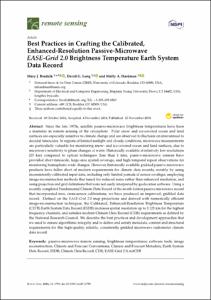Best Practices in Crafting the Calibrated, Enhanced-Resolution Passive-Microwave EASE-Grid 2.0 Brightness Temperature Earth System Data Record.

View/
Average rating
votes
Date
2018Author
Brodzik, Mary J.
Long, David. G.
Hardman, Molly A.
Metadata
Show full item recordAbstract
Since the late 1970s, satellite passive-microwave brightness temperatures have been
a mainstay in remote sensing of the cryosphere. Polar snow and ice-covered ocean and land
surfaces are especially sensitive to climate change and are observed to fluctuate on interannual to
decadal timescales. In regions of limited sunlight and cloudy conditions, microwave measurements
are particularly valuable for monitoring snow- and ice-covered ocean and land surfaces, due to
microwave sensitivity to phase changes of water. Historically available at relatively low resolutions
(25 km) compared to optical techniques (less than 1 km), passive-microwave sensors have
provided short-timescale, large-area spatial coverage, and high temporal repeat observations for
monitoring hemispheric-wide changes. However, historically available gridded passive microwave
products have fallen short of modern requirements for climate data records, notably by using
inconsistently-calibrated input data, including o.....
Resource URL
https://www.mdpi.com/2072-4292/10/11/1793Journal
Remote SensingVolume
10Issue
Article 1793Page Range
18pp.Document Language
enSustainable Development Goals (SDG)
14.aEssential Ocean Variables (EOV)
Sea iceDOI Original
https://doi.org/10.3390/rs10111793Citation
Brodzik, Mary J., Long, David G. and Hardman, Molly A. (2018) Best Practices in Crafting the Calibrated, Enhanced-Resolution Passive-Microwave EASE-Grid 2.0 Brightness Temperature Earth System Data Record. Remote Sensing, 10:1793, 18pp. DOI: https://doi.org/10.3390/rs10111793Collections
- CAPARDUS Practices [244]
The following license files are associated with this item:
 Repository of community practices in Ocean Research, Applications and Data/Information Management
Repository of community practices in Ocean Research, Applications and Data/Information Management
